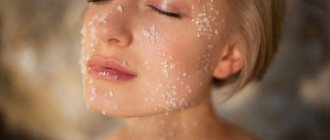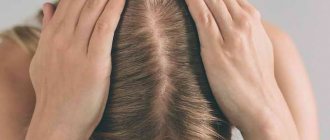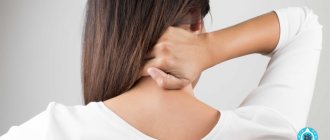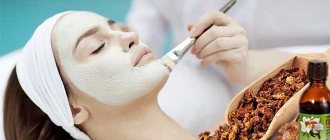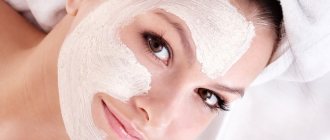Seborrheic dermatitis in the photo
Photo 1. Seborrheic dermatitis of the scalp.
Photo 2. Seborrheic dermatitis of the head.
Photo 3. Photo of seborrheic dermatitis before treatment.
Photo 4. Photo of seborrheic dermatitis after treatment.
Photo 5. Symptoms of seborrheic dermatitis: redness and peeling.
Photo 6. Symptoms of seborrheic dermatitis: the appearance of crusts.
Shampoos with zinc against seborrhea
Today, shampoos with zinc are very popular. More than a hundred brands produce shampoos with zinc to eliminate dandruff and seborrhea.
- SKIN-CAP shampoo is an original treatment based on activated zinc pyrithione, a substance with pronounced antimicrobial, anti-inflammatory and antifungal activity. The skin cap contains activated zinc pyrithione in a proportion of 1 g per 100 ml of the drug. Suitable for combating dry and oily seborrhea, dandruff and seborrheic dermatitis.
- Friederm Zinc is a cosmetic product based on zinc pyrithione. Contains a suspension of zinc pyrithione at the rate of 20 mg of active substance per 1 ml of shampoo. Helps eliminate dandruff, but is not therapeutic.
- Keto plus Keto plus is a medicinal antifungal shampoo. 1 ml of the drug contains two active components: pyrithione zinc (10 mg) and ketoconazole (20 mg). Keto plus is used for the treatment and prevention of scalp skin diseases such as pityriasis versicolor, seborrheic dermatitis, and dandruff.
- Cynovit Shampoo Cynovit is a cosmetic product used to combat dandruff on the head. It is recommended to wash your hair up to 2-3 times a week. The duration of the course is 1 month.
Seborrheic dermatitis on the scalp and sebaceous glands
The secretion of the sebaceous glands is a mixture of lipids and is called sebum. It is necessary for the healthy functioning of the skin: moisturizing it, maintaining elasticity, creating an antimicrobial protective barrier.
The skin is covered unevenly with sebaceous glands; there can be from 4 to 380 ducts per 1 cm2. They lie in the middle layer of the skin - the dermis, between its papillary and reticular layers. The largest number of sebaceous glands are located in the so-called “seborrheic zones”: on the skin of the face and body (back, neck, scalp, pubis, chest, abdomen, shoulders, forearms, legs). There are no sebaceous glands on the skin of the soles and palms.
For the most part, the ducts of the sebaceous glands open at the mouths of the hair follicles. In smaller numbers, the excretory ducts open directly onto the surface of the epidermis - in the area of the eyelids, borders of the lips, external auditory canal, nipple halos, and anus.
The size of the glands and the amount of lipid secretion depends on various factors: the functioning of the endocrine, nervous, reproductive systems of the body, age. In young children, the sebaceous glands secrete very little secretion. By adolescence, their work increases sharply, but as they grow older, their activity decreases. In adult men, sebum is constantly secreted in approximately the same amount; in women, this process is often associated with the menstrual cycle. In old age, the amount of secretion released decreases.
Hair types and their features
Features of hair care depend on the density of the hair shaft and the activity of the sebaceous glands. Trichologists distinguish the following hair types:
- normal type. The hair shaft is strong and shiny, hair grows quickly, problems include split ends with constant heat styling;
- dry type The hair shaft is dull, breaks easily, and the ends often split. Such hair requires special care: the use of moisturizers;
- fat type. Due to the high activity of the sebaceous glands, the hair shaft becomes covered with sebum and quickly becomes dirty;
- mixed type. Oily roots and dry ends. Mixed hair type is observed in people who use inappropriate cosmetics or abuse heat styling.
Seborrheic dermatitis. Varieties
Oily seborrhea is the most common type of disease. It is characterized by increased secretion of sebum and changes in skin microflora. With oily seborrhea, redness of the skin or small reddish papules with an oily sheen and clearly defined boundaries are observed. Oily seborrhea, in turn, is divided into thick and liquid, depending on changes in the composition of the skin secretion (see photo of seborrheic dermatitis).
Oily seborrhea
Oily seborrhea
With liquid seborrhea, the level of free fatty acids in sebum increases. The skin of the face becomes shiny, rough, with enlarged pores. Comedones and acne easily form on it. If liquid seborrhea affects the scalp, the hair looks very dirty and sticks together in strands.
With thick seborrhea, there is a decrease in the level of lower fatty acids and an increase in higher fatty acids in the sebum. An imbalance in the composition of skin secretions reduces its protective properties and provokes the proliferation of microorganisms. Externally, thick seborrhea can manifest itself as pustular rashes, dilation of the mouths of the ducts of the sebaceous glands, comedones, and the separation of large yellowish scales glued together.
Dry seborrhea - often observed in young children, as they produce an insufficient amount of skin secretion. In adults, the dry form of seborrheic dermatitis occurs less frequently. It is characterized by a decrease in sebum production, dryness, cracks and excessive flaking of the skin, a feeling of tightness that intensifies after contact with water. The hair on the head becomes thinner, brittle and split. In some cases, the scales layer on top of each other, forming crusts. Acne, pink and red spots appear on the skin.
Dry seborrhea
Severe seborrhea with infection
Mixed seborrhea - characterized by the simultaneous appearance of dry seborrheic dermatitis on the scalp and oily seborrheic dermatitis on the face.
How to treat pathology?
Oily seborrhea is eliminated using conservative methods. They involve the use of drugs for internal and external use.
To treat forms of seborrhea, drug therapy is prescribed.
It includes:
- vitamin complexes;
- immunomodulators;
- antimycotic and other agents.
Patients are prescribed antifungal, antibacterial, and exfoliating drugs for seborrhea. If the pathology covers a large area of skin, ointments and creams must be prescribed. Particular attention is paid to physiotherapeutic procedures, including:
- cryomassage of the head;
- laser therapy;
- ozone therapy, etc.
Oily seborrhea of the scalp should be treated comprehensively! Only in this case is it possible to achieve the desired effect.
Seborrhea of the head is treated with diet. Patients are advised to avoid fried and spicy foods, sweets, white bread, and coffee. You should add porridge, seaweed, dietary fish and meat to your diet.
Important! Treatment is carried out exclusively under the supervision of the attending physician. He regularly monitors the condition of the epidermis of the head and hair, and adjusts therapy if necessary.
Seborrheic dermatitis. Symptoms
Seborrheic dermatitis can develop both in the head and torso. Seborrhea of the scalp can manifest itself as inflammation of the scalp, eyebrows, eyelashes, hairline, nasolabial folds, external auditory canals and the area behind the ears. In men, it is often localized in the area of beard and mustache growth.
Seborrheic rash can also affect the chest and natural folds of the body: armpits, groin, abdomen, mammary glands. Seborrhea of the face and body manifests itself as red spots, accompanied by itching and peeling, a burning sensation and even the appearance of papules, merging into ring-shaped or garland-shaped plaques. The plaques have clear boundaries, the papules are covered with fatty yellowish scales. As the disease progresses, bright yellow crusts appear on the skin, inflammation grows over a large surface area of the skin, and a bacterial infection occurs.
Seborrheic dermatitis of the scalp is characterized by the detachment of whitish scales, which can be mistaken for large dandruff. However, unlike dandruff, seborrhea is accompanied by itchy skin, and the lesions are clearly visible. Many patients associate dry scalp with the appearance of “dandruff”, so they wash their hair less often. Unfortunately, such tactics, instead of the desired result, only lead to the accumulation of seborrheic scales, the formation of dense crusts and pathological inflammation of the scalp and sebaceous glands. Refusal of treatment leads to thinning hair and baldness.
Seborrhea of the scalp in infants usually appears at the age of 3 months. It consists of thick yellow crusts that can be easily removed with vegetable oil and does not bother children. However, the combination of skin rash with diarrhea and underweight in newborns requires urgent medical attention, as it may indicate the presence of such a serious disease as Leiner's erythroderma.
Diagnostics
Oily seborrhea is distinguished by characteristic symptoms. Despite this, the process of diagnosing seborrhea includes a set of measures.
First, the doctor gets acquainted with the patient's medical history. This allows you to determine what led to seborrhea. After this, he collects and analyzes his life history. This makes it possible to find out against what factors the pathology of the epidermis of the head developed. Then a thorough examination of the affected segments of the head is carried out and a complete clinical picture of the course of seborrhea is compiled.
Also, before treatment, comprehensive instrumental diagnostics are carried out. The doctor examines both skin and hair.
The main methods of examining the head and hair include:
- Skin scrapings and microscopic examination of hair.
- X-ray of the abdominal cavity.
- Ultrasound of the thyroid gland.
- CT and MRI.
Patients also undergo laboratory diagnostics. It includes a general and biochemical blood test, as well as hormonal tests. If necessary, a gynecologist and andrologist, a neurologist, an endocrinologist and other specialized doctors are involved in the examination, diagnosis and further treatment.
Seborrheic dermatitis. Causes
The main reason for the development of seborrhea is the effect on the skin of opportunistic yeast-like lipophilic fungi Malassezia furfur, which are present in varying quantities in most people. The oval form of the fungus (Pityrosporum ovale) is responsible for the development of inflammation of the scalp. Lesions on the skin of the body are caused by the round form of Malassezia furfur – Pityrosporum orbiculare. Fungi create colonies around the ducts of the sebaceous glands, feeding on lipid secretions and actively multiplying.
However, seborrheic dermatitis does not affect everyone. Thanks to the immune system, a healthy body inhibits the growth of fungi. If the body's metabolism is disrupted, Malassezia furfur begins to multiply uncontrollably, which breaks down sebum into free fatty acids, which causes inflammation.
The development of pathology can occur due to the following factors:
- puberty - due to hormonal changes in adolescents, the composition of sebum changes, and the sebaceous glands begin to work with greater intensity. In this case, the disease goes away on its own as the patient grows older;
- hereditary predisposition explaining the hyperfunction of the sebaceous glands;
- hormonal imbalance, in which there is an increase in the level of androgen and progesterone and a decrease in estrogen levels. Hormone-dependent seborrheic dermatitis is observed in women in menopause or with ovarian diseases, in men with testicular tumors, and in obesity;
- unhealthy diet with an abundance of spicy, salty and fatty foods;
- presence of bad habits (alcohol, tobacco smoking);
- infectious diseases, weakened immunity;
- stress and overwork;
- non-infectious diseases of the gastrointestinal tract, endocrine system and metabolism. Painful conditions are accompanied not only by increased work of the sebaceous glands, but also by excessive sweating and cardiac arrhythmia;
- psychological and mental diseases (for example, Itsenko-Cushing syndrome, schizophrenia, epilepsy, manic-depressive disorder), in which the functions of the pituitary gland and hypothalamus are disrupted.
But despite the extensive list of possible reasons, none of them are absolute. The exact reason contributing to the excessively active activity of Malassezia fungi has not yet been identified.
